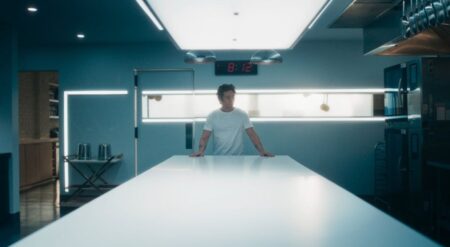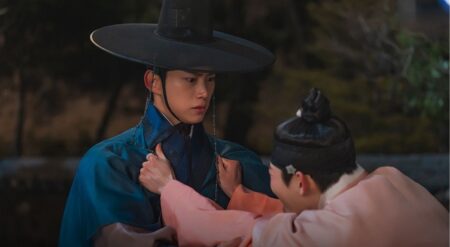Who is John Sugar? A private investigator, an ex-spy, a well-traveled polyglot, or something far more sinister? It’s a question just as arresting—and as transfixing—as the mysterious case he’s working on. In the vein of the greatest film noirs, Sugar (2024), an Apple TV+ Original, wrestles with these two intertwined riddles. And it does so with a riveting existential edge. From its pastel-hued title sequence to its final liquor-laced frame, the series drips with classic Hollywood flair.
But something wonderfully strange never fails to linger underneath the surface. Part cinematic homage, part genre subversion, creator Mark Protosevich cements an intoxicating synthesis of old and new. The show revels in its pulpy noir trappings while also pushing its boundaries. The result is a kinetic foray into the neo-noir that leaves us intrigued and confused in the best of ways.
Sugar opens with a dreamy, monochromatic vision of modern Japan, directly recalling that nation’s cinematic golden age. It’s a sequence that feels directly plucked from Akira Kurosawa’s High and Low, right down to its stirring wood-block instrumentation. Moments like these epitomize the series’ unabashed love of cinema. They’re full of visual and stylistic callbacks, deftly woven into the series’ central mystery. The show seamlessly zips between an array of styles, as if on a knife’s edge. Each style embodies a hardboiled noir in one breath and a kaleidoscopic character study in the next. Sugar is as much a love letter to cinema as it is a singular detective fable.
The series’ protagonist, the charming, all-too-dapper John Sugar (Colin Farrell), is a monument to the cinema’s storied past. When he’s not reading Cahiers du Cinéma or American Cinematographer, he’s packing the gun Glen Ford used in the Big Heat to crack missing person cases. When he’s taking a swig of whiskey or stepping into his classic blue Corvette, Sugar isn’t shy in directly tying him to the genre’s most famous figures. The show often splices in a classic Sterling Hayden or Burt Lancaster clip, directly cutting him from the same cloth. Moments like these might seem overly referential, but they really empower John’s moving narration on human nature and storytelling.

The crackling case is embroiling John centers on a famous and problematic filmmaking family. Olivia Siegal (Sydney Chandler), the granddaughter of powerful and respected Hollywood producer Jonathan Siegal (James Cromwell), goes missing. John is quickly assigned to find her, uncovering the Siegal family’s darkest secrets in the process.
Which, appropriately, include hidden affairs, sexual misconduct, and familial strife. As he gets closer to finding her, we too begin to peel back the layers of his identity. We also uncover his true purpose in Los Angeles, and the world, for that matter. Like the most memorable noirs, Sugar uses its genre frame to interrogate subtle human truths and cinema’s most impactful tropes.
Fernando Meirelles, who directs five of the series’ eight episodes, luxuriates in its noir DNA. He captures each glance, conversation, and revelation with the pulpiest touch. Sugar is full of breathtaking wides, intoxicating Dutch angles, and scintillating close-ups that breathe life into its mystery. Not to mention a flurry of iconic iris transitions and blissfully hokey car backdrops. It all instills a sense of timelessness and specificity.
These impactful choices all culminate in an experience that repeatedly taps into the moral rot of an industry it also reveres. It’s all part of a fascinating cadence. There’s plenty to chew on, outside of the facts of the case. Yet, for how steeped in classic Hollywood these flourishes are, Sugar never fails to feel sleek and modern in design. Sugar is awash with dreamy neons and even dreamier sunsets. The show finds itself at a lush cross-section between mid-century elegance and new-age depravity.

Farrell seems factory-made for his role, embodying the piercing suavity of his predecessors. Albeit, he carries a tincture of tenderness. He’s a man whose first weapon is his wit. His second is his manners, possessing an almost unearthly ability to sniff out lies and get on others’ good sides. Farrell’s glazed, longing visage epitomizes the arms-length John keeps from meaningful connection. As he’s forced into more violent situations, a more primal—and ultimately human—version of him surfaces. Farrell brings a tremendous amount of range to a character who’s defined by his stoicism. He crafts a persona that sits comfortably next to the legendary heroes he’s derived from.
As Sugar moves into its second half, it injects a genre-blending wrinkle that threatens to go off the deep end. But it too ultimately becomes an act of homage and subversion. It recalls schlocky b-noirs to underpin its commentary on the genre. Sugar takes bold swings that both celebrate and deconstruct the detective story. It’s exactly what a noir thrust into the 21st century should be: thought-provoking, stylish, and utterly confounding.
Sugar (2024) is streaming exclusively on Apple TV+ now, with new episodes every Friday.
Sugar
-
Rating - 9/109/10
TL;DR
Sugar is exactly what a noir thrust into the 21st century should be: thought-provoking, stylish, and utterly confounding.







